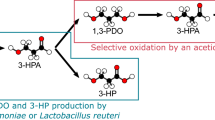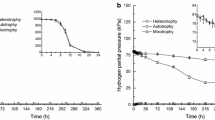Abstract
Acetobacter pasteurianus LMG 1635 was studied for its potential application in the enantioselective oxidation of alcohols. Batch cultivation led to accumulation of acetic acid and loss of viability. These problems did not occur in carbon-limited chemostat cultures (dilution rate = 0.05 h−1) grown on mineral medium supplemented with ethanol, L-lactate or acetate. Nevertheless, biomass yields were extremely low in comparison to values reported for other bacteria. Cells exhibited high oxidation rates with ethanol and racemic glycidol (2,3-epoxy-1-propanol). Ethanol- and glycidol-dependent oxygen-uptake capacities of ethanol-limited cultures were higher than those of cultures grown on lactate or acetate. On all three carbon sources, A. pasteurianus expressed NAD-dependent and dye-linked ethanol dehydrogenase activity. Glycidol oxidation was strictly dye-linked. In contrast to the NAD-dependent ethanol dehydrogenase, the activity of dye-linked alcohol dehydrogenase depended on the carbon source and was highest in ethanol-grown cells. Cell suspensions from chemostat cultures could be stored at 4°C for over 30 days without significant loss of ethanol- and glycidol-oxidizing activity. It is concluded that ethanol-limited cultivation provides an attractive system for production of A. pasteurianus biomass with a high and stable alcohol-oxidizing activity.
Similar content being viewed by others
References
Alexander B, Leach S, Ingledew WJ (1987) The relationship between chemiosmotic parameters and sensitivity to anions and organic acids in the acidophile Thiobacillus ferrooxidans. J Gen Microbiol 133:1171–1179
Asai T (1968) Acetic acid bacteria. Classification and biochemical activities. University of Tokyo Press, Japan
Avignon-Tropis M, Treilhou M, Pougny JR, Fréchard-Ortuno I, Linstrumelle G (1991) Total synthesis of ( + )-leukotriene B4 methyl ester and its 5-epimer from (R)-glycidol. Tetrahedron 49:7279–7286
De Ley J (1958) Studies on the metabolism of Acetobacter peroxydans. I. General properties and taxonomic position of the species. Antonie van Leeuwenhoek 24:281–297
De Ley J, Kersters K (1964) Oxidation of alipathic glycols by acetic bacteria. Bacteriol Rev 28:164–180
De Ley J, Schell J (1959). Studies on the metabolism of Acetobacter peroxydans. II. The enzymic mechanism of lactate metabolism. Biochim Biophys Acta 35:54–165
Ebner H, Follmann H (1983) Acetic acid. In: Dellweg H (ed) Biotechnology, vol 3. Biomass, microorganisms for special applications, microbial products, energy from renewable sources. VCH, Weinheim, pp 387–407
Geerlof A, Tol JBA van, Jongejan JA, Duine JA (1994) Enantioselective conversions of the racemic C3-alcohol synthons, glycidol (2,3-epoxy-1-propanol), and solketal (2,2-dimethyl-4-hydroxymethyl)-1,3-dioxolane) by quinohaemoprotein alcohol dehydrogenases and bacteria containing such enzymes. Biosci Biotechnol Biochem 58:1028–1036
Heijnen JJ, Roels JA (1981) A macroscopic model describing yield and maintenance relationships in aerobic fermentation. Biotechnol Bioeng 23:739–763
Hummel W, Kula MR (1989) Dehydrogenases for the synthesis of chiral compounds. Eur J Biochem 184:1–13
Kloosterman M, Elferink VHM, van Iersel J, Roskam JH, Meijer EM, Hulshof LA, Sheldon RA (1988) Lipase in the preparation of β-blockers. Trends Biotechnol 6:251–256
Klunder JM, Ko SY, Sharpless KB (1986) Assymmetric epoxidation of allyl alcohol: efficient routes to homochiral β-adrenergic blocking agents. J Org Chem 51:3710–3712
Linton JD (1990) The relationship between metabolite production and the growth efficiency of the producing organism. FEMS Microbiol Rev 75:1–18
Matsushita K, Toyama H, Adachi O (1994) Respiratory chains and bioenergetics of acetic acid bacteria. Adv Microb Physiol 36:247–301
Postma E, Verduyn C, Scheffers WA, van Dijken JP (1989) Enzymic analysis of the Crabtree effect in glucose-limited cultures of Saccharomyces cerevisiae. Appl Environ Microbiol 55:468–477
Takemura H, Kondo K, Horinouchi S, Beppu T. (1993) Induction by ethanol of alcohol dehydrogenase activity in Acetobacter pasteurianus. J Bacteriol 175:6857–6866
Van Urk H, Mak PR, Scheffers WA, Dijken JP van. (1988) Metabolic responses of Saccharomyces cerevisiae CBS 8066 and Candida utilis CBS 621 upon transition from glucose limitation to glucose excess. Yeast 4:283–291
Verduyn C, Postma E, Scheffers WA, Dijken JP van. (1992) Effect of benzoic acid on metabolic fluxes in yeasts: a continous-culture study on the regulation of respiration and alcoholic fermentation. Yeast 8:501–517
Visser't Hooft F (1925) Biochemische onderzoekingen over het geslacht Acetobacter. PhD Thesis, Delft University of Technology, Delft
Author information
Authors and Affiliations
Rights and permissions
About this article
Cite this article
Salgueiro Machado, S., Luttik, M.A.H., van Dijken, J.P. et al. Regulation of alcohol-oxidizing capacity in chemostat cultures of Acetobacter pasteurianus . Appl Microbiol Biotechnol 43, 1061–1066 (1995). https://doi.org/10.1007/BF00166926
Received:
Revised:
Accepted:
Issue Date:
DOI: https://doi.org/10.1007/BF00166926




